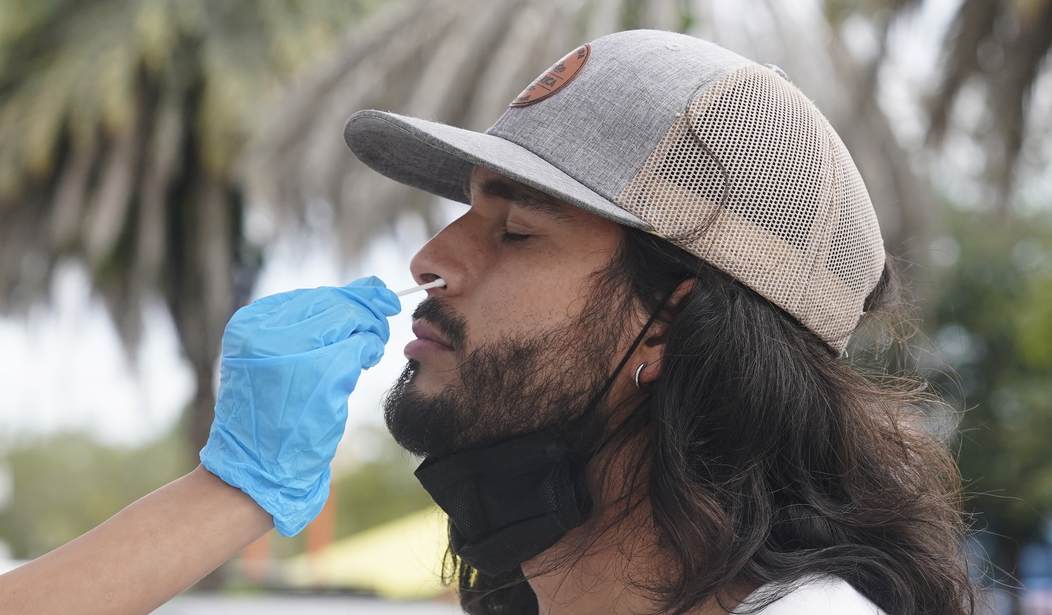There really has been a summer COVID wave. Although you’re forgiven if you failed to notice because you’ve been preoccupied with news about the current monkeypox wave instead.
Or, uh, the current polio wave.
Every day I check the COVID scoreboard on Drudge. And every day I have to remind myself that these numbers are misleading, that we’ve made vastly more progress than his data would imply.

After another year of vaccines, new therapeutics, and half-assed masking and social distancing, case counts and daily deaths are … nearly identical to what they were 12 months ago? Are we ever going to make headway against this disease?
We have made headway, though. Lots. For starters, case counts today can’t be compared to case counts a year ago because at-home rapid tests are far more prevalent now than they were then. Figure that, in August 2021, positive lab tests were picking up one of every four infections; in August 2022, that ratio may be closer to one in 10 or greater. Which means, although daily deaths are comparable, the true number of daily infections may be two or three times than what it was last year, producing a case fatality rate that’s far lower today than it was a year ago. “The mortality rate [for hospitalized patients] now is very low: It’s around 2%, and it was around 10 to 12% during Delta,” said the head of New York’s largest health-care provider recently to CNN.
The other point to bear in mind is that, while it’s true that the number of deaths a year ago was nearly identical to the number of deaths today, early August 2021 was still just the beginning of the ferocious Delta wave that blitzed the American south. Within two weeks, the country was averaging a thousand deaths per day. By the end of September, when the wave peaked, it was averaging two thousand. The worst was yet to come, and the worst ended up being awfully bad. Contrast that with the case curve over the past two weeks:

Cases have *dropped* slightly from where they stood in mid-July.
But yes, okay, fine: We can’t rely much on official case counts anymore knowing that most infections are being recorded on at-home tests rather than lab tests. Fair enough. So how about hospitalizations as a measure of where the summer wave stands?

Hospitalizations are also declining over the past two weeks. And although it’s hard to tell from that graph, the number of ICU cases has also dipped from nearly 5,100 on July 30 to slightly under 5,000 now. That’s only modest improvement, of course, but on yesterday’s date one year ago more than 16,000 Americans were in the ICU because of Delta with the number still climbing. Eventually it would peak in early September at more than 26,000 in intensive care and more than 100,000 hospitalized generally. Not only does it seem unlikely we’ll approach that this summer, it looks like we’ve already seen our peak.
Those who are unlucky enough to end up in the hospital nowadays tend to be older, undervaccinated, and suffering from at least one comorbidity. If you’re vaxxed up and otherwise in good health, your risk is minimal:
The Northwell data looks at 1,961 patients in its 21 hospitals from May 1 to July 31. The data includes people who were admitted because they had Covid and not patients who were admitted for other reasons and then tested positive for the virus.
Of these hospital patients, 66% were over 70, 15% were in their 60s, and 8% were in their 50s.
Across all ages, 89% of the patients had an underlying health problem such as hypertension, diabetes or coronary artery disease.
Of all patients hospitalized for Covid, 47% had not had a single Covid shot, 21% had had only one or two shots, and 32% were fully vaccinated and boosted. Among that last group, 78% were 65 or older.
As for daily deaths:

The bad news is that there’s been no meaningful decline in three months. To the contrary, deaths have inched upwards to more than 500 per day, a pace of 180,000 per year if it held for 12 months. Even in its more quiescent stage, COVID still ain’t “just the flu.” But as you can see, the dynamics of daily deaths now versus during the Delta wave a year ago are night and day. In fact, not since the historic Omicron wave this past winter has America seen a true surge in deaths. For better or worse, the current moment is what endemic COVID probably looks like for the foreseeable future.
One more graph for you. Here’s the CDC’s data on wastewater surveillance. The graph is slightly more blue than red lately, which means a majority of sites tested are seeing less virus than they had been:

It sure seems like the summer wave, such as it is, is gradually receding. And the CDC looks ready to adjust its guidance accordingly:
The Centers for Disease Control and Prevention is expected to relax its COVID-19 recommendations in the coming days, starting with schools, just as students head back to the classroom.
CBS News obtained a copy of the CDC draft document outlining the rationale for the change. While not yet final, the changes could include deemphasizing the “test to stay” strategy, in which students exposed to COVID-19 take regular tests to stay in the classroom. Schools would also be free to unwind strict social distancing measures, which the CDC’s guidance has already effectively phased out…
“This virus is going to be here with us in the days ahead, and we have got to learn to live with it,” infectious disease expert Michael Osterholm told CBS News.
If even Michael “Dr. Doom” Osterholm thinks it’s time to chill out and get back to normal, the pandemic phase of COVID is truly over. Someone should tell America!








Join the conversation as a VIP Member